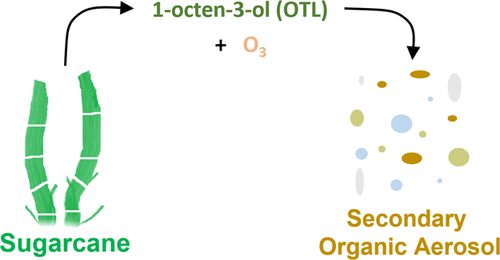当前位置:
X-MOL 学术
›
ACS Earth Space Chem.
›
论文详情
Our official English website, www.x-mol.net, welcomes your
feedback! (Note: you will need to create a separate account there.)
Ozonolysis Chemistry and Phase Behavior of 1-Octen-3-ol-Derived Secondary Organic Aerosol
ACS Earth and Space Chemistry ( IF 2.9 ) Pub Date : 2020-06-01 , DOI: 10.1021/acsearthspacechem.0c00092 Kevin B. Fischer 1 , Clarissa S. Gold 1 , Rebecca M. Harvey 1 , Adam N. Petrucci 1 , Giuseppe A. Petrucci 1
ACS Earth and Space Chemistry ( IF 2.9 ) Pub Date : 2020-06-01 , DOI: 10.1021/acsearthspacechem.0c00092 Kevin B. Fischer 1 , Clarissa S. Gold 1 , Rebecca M. Harvey 1 , Adam N. Petrucci 1 , Giuseppe A. Petrucci 1
Affiliation

|
Secondary organic aerosol (SOA) is ubiquitous in the atmosphere and plays important roles in environmental chemical processes, influencing air quality and the Earth’s radiative budget. In the present work, 1-octen-3-ol (OTL) was identified as one of several prominent green leaf volatiles (GLVs) emitted as a result of sugarcane wounding. GLVs, a subset of volatile organic compounds (VOCs), act as SOA precursors and are a potentially underrepresented source of the overall SOA budget. Here, ozonolysis experiments of OTL standards were carried out in Teflon chambers in conjunction with a scanning mobility particle sizer (SMPS), an electrical low pressure impactor (ELPI+), and a near-infrared laser desorption ionization aerosol mass spectrometer (NIR-LDI-AMS). Under our experimental conditions, the OTL ozonolysis rate constant and aerosol yield were estimated to be 5.00 ± 0.58 × 10–24 cm3 s–1 molecule–1 and 1.03 ± 0.07%, respectively. Bounce factor (BF) calculations based on the ELPI+ data at relative humidity (RH) levels of 5, 30, 60, and 90% suggest that the OTL-derived SOA exhibits largely non-liquid characteristics regardless of RH levels at particle genesis. Furthermore, high RH at particle genesis also appears to decrease the hygroscopicity of the SOA, impacting its ability to activate as cloud droplets. Online chemical analysis of the SOA using a NIR-LDI-AMS supports the production of oxygenated products ranging from 45 to 161 m/z, in addition to prominent oligomers well beyond this m/z range.
中文翻译:

1-Octen-3-ol衍生的次级有机气溶胶的臭氧分解化学和相行为
二次有机气溶胶(SOA)在大气中无处不在,在环境化学过程中起着重要作用,影响空气质量和地球的辐射预算。在目前的工作中,1-辛烯-3-醇(OTL)被确定为甘蔗受伤造成的几种突出的绿叶挥发物(GLV)之一。GLV是挥发性有机化合物(VOC)的子集,可充当SOA的前身,并且可能是总体SOA预算中代表性不足的来源。在这里,与扫描迁移率粒度仪(SMPS),低压电撞击器(ELPI +)和近红外激光解吸电离气溶胶质谱仪(NIR-LDI-)一起在特氟龙室内进行OTL标准品的臭氧分解实验AMS)。在我们的实验条件下–24 cm 3 s –1分子–1和1.03±0.07%。基于相对湿度(RH)分别为5、30、60和90%时ELPI +数据的反弹因子(BF)计算表明,无论颗粒产生时的RH水平如何,源自OTL的SOA都表现出很大的非液体特性。此外,粒子发生时的高RH也似乎会降低SOA的吸湿性,从而影响其作为云滴活化的能力。使用NIR-LDI-AMS对SOA进行在线化学分析,可支持生产氧化范围为45至161 m / z的氧化产物,此外还可以提供远远超过此m / z范围的重要低聚物。
更新日期:2020-06-01
中文翻译:

1-Octen-3-ol衍生的次级有机气溶胶的臭氧分解化学和相行为
二次有机气溶胶(SOA)在大气中无处不在,在环境化学过程中起着重要作用,影响空气质量和地球的辐射预算。在目前的工作中,1-辛烯-3-醇(OTL)被确定为甘蔗受伤造成的几种突出的绿叶挥发物(GLV)之一。GLV是挥发性有机化合物(VOC)的子集,可充当SOA的前身,并且可能是总体SOA预算中代表性不足的来源。在这里,与扫描迁移率粒度仪(SMPS),低压电撞击器(ELPI +)和近红外激光解吸电离气溶胶质谱仪(NIR-LDI-)一起在特氟龙室内进行OTL标准品的臭氧分解实验AMS)。在我们的实验条件下–24 cm 3 s –1分子–1和1.03±0.07%。基于相对湿度(RH)分别为5、30、60和90%时ELPI +数据的反弹因子(BF)计算表明,无论颗粒产生时的RH水平如何,源自OTL的SOA都表现出很大的非液体特性。此外,粒子发生时的高RH也似乎会降低SOA的吸湿性,从而影响其作为云滴活化的能力。使用NIR-LDI-AMS对SOA进行在线化学分析,可支持生产氧化范围为45至161 m / z的氧化产物,此外还可以提供远远超过此m / z范围的重要低聚物。











































 京公网安备 11010802027423号
京公网安备 11010802027423号